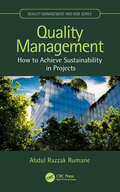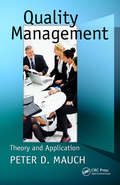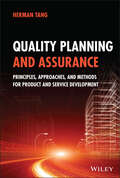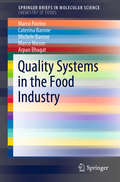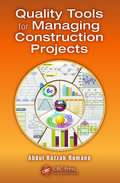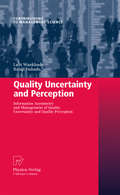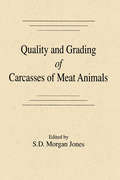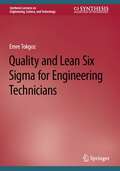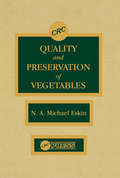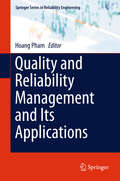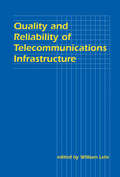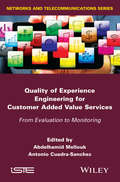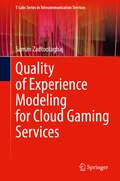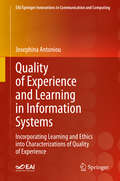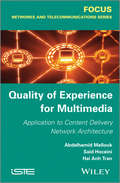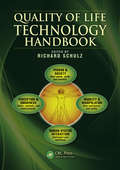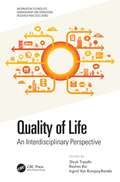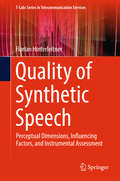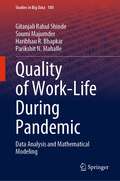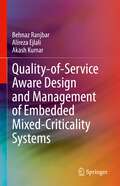- Table View
- List View
Quality Management: How to Achieve Sustainability in Projects (Quality Management and Risk Series)
by Abdul Razzak RumaneDivided into four main chapters, this book covers the inception on through to the handover of a project and details the three main stages (study stage, design stage, and construction stage) involved with managing any type of project. The book discusses the sustainability framework and provides an overview of quality management with construction projects along with the most common quality tools used to manage quality and achieve sustainability in projects. Quality Management: How to Achieve Sustainability in Projects takes the reader from start to finish with a focus on the sustainability elements needed to manage quality in projects and details the application of sustainability principles at different stages. The book discusses the quality tools used in managing sustainability and provides concise and complete information on how to easily achieve it through to the project handover stage. The book is written for Project Management professionals such as Project Managers, Quality Managers, Industrial Engineers, and Construction Managers, as well as Design Management professionals, academics, trainers, and graduate students.
Quality Management: Theory and Application
by Peter D. MauchIn the past, when goods and services were simpler, measurement of quality was self-evident. As business became more complicated, so too did the implementation of quality management and our ability to measure it. Ultimately, the practice of quality strayed from being a business practice to become much more of an engineering discipline producing plen
Quality Planning and Assurance: Principles, Approaches, and Methods for Product and Service Development
by Herman TangQUALITY PLANNING AND ASSURANCE Discover the most crucial aspects of quality systems planning critical to manufacturing and service success In Quality Planning and Assurance: Principles, Approaches, and Methods for Product and Service Development, accomplished engineer Dr. Herman Tang delivers an incisive presentation of the principles of quality systems planning. The book begins with an introduction to the meaning of the word “quality” before moving on to review the principles of quality strategy and policy management. The author then offers a detailed discussion of customer needs and the corresponding quality planning tasks in design phases, as well as a treatment of the design processes necessary to ensure product or service quality. Readers will enjoy explorations of advanced topics related to proactive approaches to quality management, like failure modes and effects analysis (FMEA). They???ll discover discussions of issues like supplier quality management and the key processes associated with quality planning and execution. The book also includes: A thorough introduction to quality planning, including definitions, discussions of quality system, and an overview of the planning process A comprehensive exploration of strategic planning development, including strategic management, risk management and analysis, and pull and push strategies Practical discussions of customer-centric planning, including customer-oriented design, quality function deployment, and affective engineering In-depth examinations of quality assurance by design, including the design review process, design verification and validation, and concurrent engineering Perfect for senior undergraduate and graduate students in technology and management programs, Quality Planning and Assurance will also earn a place in the libraries of managers and technical specialists in a wide range of fields, including quality management.
Quality Systems in the Food Industry (SpringerBriefs in Molecular Science)
by Arpan Bhagat Marco Fiorino Caterina Barone Michele Barone Marco MasonThis book explains the role of food-oriented (or ‘food-centric’) quality system standards in the modern food and beverage industry. It discusses food safety schemes based on the international norm ISO 9001 and the “Hazard Analysis and Critical Control Points” approach, and also introduces the new Global Standard for Food Safety (GSFS) and the International Featured Standard (IFS, 7th ed.), outlining standardization for international equivalence (while maintaining the necessary flexibility and independence – which is not always easy an easy task).Providing selected specific examples, it examines the problems of chemical additives and possible cross-contaminations between different production lines, as well as adequate reactions to and handling of intentional adulterations. In addition, it includes a chapter focusing on quality audits and technical data sheets in the food industry, and a final chapter describing the certification of food-grade lubricants in the food industry, especially with regard to allergenic substances.
Quality Tools for Managing Construction Projects (Systems Innovation Book Series)
by Abdul Razzak RumaneDealing with such a multi-layered and fungible intangible as quality during the design and construction process is difficult for all parties involved. To the architect, quality means an appealing and enduring design, but to the builder, it means understandable documents that, when acted upon, lead to an enduring, well-made structure. To the owner,
Quality Uncertainty and Perception
by Lalit Wankhade Balaji DabadeThe book addresses the complex issue of quality uncertainty due to information asymmetry in the backdrop of information economics, total quality management and marketing science. Reliability Engineering, Seven Management Tools and System Dynamics are used to develop theories on quality uncertainty and perception. Quality perception is identified as a multidisciplinary measure of business performance. The tools are developed to minimize quality uncertainty or to maximize quality perception. A few worksheets are provided for applying these theories to improve business performance.
Quality and Grading of Carcasses of Meat Animals
by S. Morgan JonesThree main factors affect the quality and composition of meat in farm animals. Production conditions determine the composition of the meat, while marketing and postmortem periods have a major bearing on the visual appearance and ultimate eating experience for the consumer. It is often difficult to compare research results from different countries since meat quality is assessed by a wide variety of procedures. Quality and Grading of Carcasses of Meat Animals reviews the development of commercial grading or classification schemes on a world-wide basis, and it provides a broad outline of the most common subjective and objective procedures for the assessment of meat quality.The book provides reviews on:Ante- and post-mortem effects on meat qualityReducing fatness in meat animalsPrediction of carcass composition and meat qualityWorld carcass and grading systemsElectronic identification of animals
Quality and Lean Six Sigma for Engineering Technicians (Synthesis Lectures on Engineering, Science, and Technology)
by Emre TokgozThis textbook is the first of its kind, designed exclusively for the training and professional development of engineering technicians and technologists on the quality concepts, tools, and skills necessary for today's industrial environment. The book provides learners and working professionals with numerous examples, exercises, and case studies to prepare them to apply concepts including total quality management (TQM), six sigma, and lean methodology in analyzing and solving quality problems and implementing process improvements and corrective actions in the manufacturing process.Quality and Lean Six Sigma for Engineering Technicians gives readers a practical understanding of six sigma and manufacturing improvement concepts. It is also a go-to reference for practicing engineering technicians already working in the field.
Quality and Preservation of Fruits
by N. A. EskinThis book discusses the agronomic factors affecting the quality of major fruits grown in North America, as well as the storage and processing of these crops. Quality factors discussed include appearance, texture, flavor, and nutritional quality. Fruits covered include oranges, grapefruit, lemons, grapes, apples, peaches, nectarines, plums, strawberries, pears, and cherries. Quality and Preservation of Fruits is a detailed reference resource for researchers and teachers in horticulture and food science.
Quality and Preservation of Vegetables
by Michael EskinThis comprehensive work discusses those factors which contribute to the overall quality of the major vegetables grown in North America for the fresh market as well as methods for storing and preserving these crops. The qualities which determine the suitability of a crop for processing is also discussed since the majority of vegetables, with the exception of lettuce and celery, are processed for the retail market. The selection of vegetables is based on their economic importance although several others are included for completion.
Quality and Reliability Management and Its Applications
by Hoang PhamIntegrating development processes, policies, and reliability predictions from the beginning of the product development lifecycle to ensure high levels of product performance and safety, this book helps companies overcome the challenges posed by increasingly complex systems in today's competitive marketplace. Examining both research on and practical aspects of product quality and reliability management with an emphasis on applications, the book features contributions written by active researchers and/or experienced practitioners in the field, so as to effectively bridge the gap between theory and practice and address new research challenges in reliability and quality management in practice. Postgraduates, researchers and practitioners in the areas of reliability engineering and management, amongst others, will find the book to offer a state-of-the-art survey of quality and reliability management and practices.
Quality and Reliability of Telecommunications Infrastructure: Quality And Reliability Of Telecommunications Infrastructure (LEA Telecommunications Series)
by William LehrIn the last decade, the technology, regulation, and industry structure of our information infrastructure (telephone services, cable and broadcast television, and myriad new data and information services) have changed dramatically. Since the break-up of AT&T's Bell System monopoly, telephone services in the United States are no longer purchased from a single firm. Advances in fiber optics, wireless communications and software-controlled switching are changing how communication services are provided. As the global economy grows more dependent on a hybrid mix of interconnected networks, public officials in the US and abroad are relinquishing control of the market. All of these changes are affecting the quality and reliability of the telecommunications infrastructure, but informed discussions of the public policy and economic issues are scarce. Deregulation and increased competition have lowered prices, but have service quality and reliability suffered? Do advanced network technologies which make it possible to offer a dizzying array of new services increase vulnerability to system-wide failures? Who should or is likely to bear the costs of increased -- or decreased -- service quality? This volume tackles the economic and public policy issues raised by these difficult questions for an audience of industry executives, scholars, and policymakers. Leading scholars and analysts examine such issues as the effects of network ownership on incentives to invest in quality improvements and/or strategies for quality-differentiated pricing in tomorrow's broadband, integrated networks. They analyze the quality of current telecommunications networks and the impact of re-regulation on cable television quality. The contributions range from new microeconomic theory to new empirical research. As such, the volume makes a valuable contribution to the public debate on network quality and reliability. It will be useful both as an introduction to newcomers and as a resource for more experienced researchers. As regulatory, industry and national barriers to integrated communications fall, these issues are likely to become even more important. The research presented here provides a solid foundation for further discussion.
Quality in the Era of Industry 4.0: Integrating Tradition and Innovation in the Age of Data and AI
by Kai YangQUALITY IN THE ERA OF INDUSTRY 4.0 Enables readers to use real-world data from connected devices to improve product performance, detect design vulnerabilities, and design better solutions Quality in the Era of Industry 4.0 provides an insightful guide to harnessing user performance and behavior data through AI and other Industry 4.0 technologies. This transformative approach enables companies to not only optimize products and services in real-time, but also to anticipate and mitigate likely failures proactively. In a succinct and lucid style, the book presents a pioneering framework for a new paradigm of quality management in the Industry 4.0 landscape. It introduces groundbreaking techniques such as utilizing real-world data to tailor products for superior fit and performance, leveraging connectivity to adapt products to evolving needs and use-cases, and employing cutting-edge manufacturing methods to create bespoke, cost-effective solutions with greater efficiency. Case examples featuring applications from the automotive, mobile device, home appliance, and healthcare industries are used to illustrate how these new quality approaches can be used to benchmark the product’s performance and durability, maintain smart manufacturing, and detect design vulnerabilities. Written by a seasoned expert with experience teaching quality management in both corporate and academic settings, Quality in the Era of Industry 4.0 covers topics such as: Evolution of quality through industrial revolutions, from ancient times to the first and second industrial revolutions Quality by customer value creation, explaining differences in producers, stakeholders, and customers in the new digital age, along with new realities brought by Industry 4.0 Data quality dimensions and strategy, data governance, and new talents and skill sets for quality professionals in Industry 4.0 Automated product lifecycle management, predictive quality control, and defect prevention using technologies like smart factories, IoT, and sensors Quality in the Era of Industry 4.0 is a highly valuable resource for product engineers, quality managers, quality engineers, quality consultants, industrial engineers, and systems engineers who wish to make a participatory approach towards data-driven design, economical mass-customization, and late differentiation.
Quality of Experience Engineering for Customer Added Value Services: From Evaluation to Monitoring
by Abdelhamid Mellouk Antonio Cuadra-SanchezThe main objective of the book is to present state-of-the-art research results and experience reports in the area of quality monitoring for customer experience management, addressing topics which are currently important, such as service-aware future Internet architecture for Quality of Experience (QoE) management on multimedia applications. In recent years, multimedia applications and services have experienced a sudden growth. Today, video display is not limited to the traditional areas of movies and television on TV sets, but these applications are accessed in different environments, with different devices and under different conditions. In addition, the continuous emergence of new services, along with increasing competition, is forcing network operators and service providers to focus all their efforts on customer satisfaction, although determining the QoE is not a trivial task. This book addresses the QoE for improving customer perception when using added value services offered by service providers, from evaluation to monitoring and other management processes.
Quality of Experience Modeling for Cloud Gaming Services (T-Labs Series in Telecommunication Services)
by Saman ZadtootaghajThis book presents the development of a gaming quality model to predict the gaming Quality of Experience (QoE) of players that could be used for planning the network service or quality monitoring of cloud gaming services. The author presents a model that is developed following a modular structure approach that keeps the different types of impairments separately. The book shows how such a modular structure allows developing a sustainable model as each component can be updated by advances in that specific research area or technology. The presented gaming quality model takes into account two modules of video quality and input quality. The latter considers the interactivity aspects of gaming. The video quality module offers a series of models that differ depending on the level of access to the video stream information, allowing high flexibility for service providers regarding the positions of measuring points within their system. In summary, the present book focuses on (1) creation of multiple image/video and cloud gaming quality datasets, (2) development of a gaming video classification, and (3) development of a series of gaming QoE models to predict the gaming QoE depending on the level of access to the video stream information.
Quality of Experience and Learning in Information Systems: Incorporating Learning and Ethics into Characterizations of Quality of Experience (EAI/Springer Innovations in Communication and Computing)
by Josephina AntoniouThe book shows how researchers, practitioners, and designers can improve user experiences with technology by understanding various user learning styles and characteristics when they interact with new and challenging applications and interfaces. Quality of experience in this new technological environment is affected by the learning curve involved in being able to use the new interfaces in a satisfactory way. The author explores the variations in quality of experience when considering learning and ethics when interacting with new, emerging technologies. The author shows how results can be applied to technologies such as big data, AI, 5G, and Internet of Things (IoT). Taken into account are also safety and security requirements, context, environment, etc. The book explores the idea of learning, ethics, and the idea that there exists a “recipe” for a satisfactory interaction with technology if such relevant parameters are taken into consideration.Analyzes user habits to improve quality of experience when interacting with technology;Shows how to apply quality of service techniques to 5G, IoT, big data and AI;Uses behavior models to analyze interactions to improve the user quality of experience.
Quality of Experience for Multimedia: Application to Content Delivery Network Architecture
by Abdelhamid Mellouk Said Hoceini Hai Anh TranBased on a convergence of network technologies, the Next Generation Network (NGN) is being deployed to carry high quality video and voice data. In fact, the convergence of network technologies has been driven by the converging needs of end-users.The perceived end-to-end quality is one of the main goals required by users that must be guaranteed by the network operators and the Internet Service Providers, through manufacturer equipment. This is referred to as the notion of Quality of Experience (QoE) and is becoming commonly used to represent user perception. The QoE is not a technical metric, but rather a concept consisting of all elements of a user's perception of the network services. The authors of this book focus on the idea of how to integrate the QoE into a control-command chain in order to construct an adaptive network system. More precisely, in the context of Content-Oriented Networks used to redesign the current Internet architecture to accommodate content-oriented applications and services, they aim to describe an end-to-end QoE model applied to a Content Distribution Network architecture. About the Authors Abdelhamid Mellouk is Full Professor at University of Paris-Est C-VdM (UPEC), Networks & Telecommunications (N&T) Department and LiSSi Laboratory, France. Head of several executive national and international positions, he was the founder of the Network Control Research activity at UPEC with extensive international academic and industrial collaborations. His general area of research is in adaptive real-time control for high-speed new generation dynamic wired/wireless networks in order to maintain acceptable Quality of Service/Experience for added-value services. He is an active member of the IEEE Communications Society and has held several offices including leadership positions in IEEE Communications Society Technical Committees.Said Hoceini is Associate Professor at University of Paris-Est C-VdM (UPEC), Networks & Telecommunications (N&T) Department and LiSSi Laboratory, France. His research focuses on routing algorithms, quality of service, quality of experience, and wireless sensor networks, as well as bio-inspired artificial intelligence approaches. His work has been published in several international conferences and journals and he serves on several TPCs.Hai Anh Tran is Associate Professor at the Hanoi University of Science and Technology (HUST), Vietnam. His research focuses on QoE aspects, QoS adaptive control/command mechanisms, wired routing, as well as bio-inspired artificial intelligence approaches.
Quality of Life Technology Handbook (Rehabilitation Science in Practice Series)
by Richard SchulzA collaboration between leading scientists, practitioners, and researchers at Carnegie-Mellon University and the University of Pittsburgh, this book is a comprehensive resource describing Quality of Life technologies and their development, evaluation, adoption, and commercialization. It takes an interdisciplinary team approach to the process of tec
Quality of Life and Daily Travel (Applying Quality Of Life Research Ser.)
by Dick Ettema Margareta Friman Lars E. OlssonThis volume analyses the relevance of daily travel in the quality of life of individuals. It provides a broad understanding of the links between life satisfaction, well-being and travel, the importance of commuting, and different evaluations and measures to assess the experience of commuting and quality of life. Chapters in this book relate travel and quality of life to the built environment, accessibility and exclusion, travel mode choice, travel satisfaction and emotions. It brings together distinguished researchers from a variety of academic backgrounds providing conceptualizations and applications, presented as case studies, for daily travel and well-being. Findings presented in this book are highly relevant for transport planners, transport marketers, public transport authorities, and environmental professionals in the pursuit of improving people’s life.
Quality of Life: An Interdisciplinary Perspective (Information Technology, Management and Operations Research Practices)
by Shruti Tripathi Rashmi Rai Ingrid Van Rompay-BartelsQuality of Life: An Interdisciplinary Perspective presents the Quality of Life using a contemporary and interdisciplinary approach. Various socio-cultural, spiritual, technological, and human factors aspects, which have an immense bearing on our lives, are an integral part of this book. This book highlights cultural differences in terms of Quality of Life. It recognizes the presence of cultural differences resulting from the social status attributed to an individual’s age, gender, class, race, and ethnicity. It can be used as a guide in the field of global well-being and for future research. It presents clues to complex problems and empirical materials, and attempts to bring out a more comprehensive picture of global and contemporary Quality of Life and well-being. This book can also fill a gap in teaching and research. Those who will find this book useful are researchers, academicians, practitioners, and students of management, behavioral science, human factors, psychology, health economics, sociology, public health, and politics.
Quality of Synthetic Speech
by Florian HinterleitnerThis book reviews research towards perceptual quality dimensions of synthetic speech, compares these findings with the state of the art, and derives a set of five universal perceptual quality dimensions for TTS signals. They are: (i) naturalness of voice, (ii) prosodic quality, (iii) fluency and intelligibility, (iv) absence of disturbances, and (v) calmness. Moreover, a test protocol for the efficient indentification of those dimensions in a listening test is introduced. Furthermore, several factors influencing these dimensions are examined. In addition, different techniques for the instrumental quality assessment of TTS signals are introduced, reviewed and tested. Finally, the requirements for the integration of an instrumental quality measure into a concatenative TTS system are examined.
Quality of Water Resources in Poland (Springer Water)
by Martina Zeleňáková Abdelazim M. Negm Katarzyna Kubiak-WójcickaThis book presents state-of-the-art knowledge concerning water quality in Poland. It offers a wide variety of cases and issues on water resource quality management. The book also presents different methods and strategies to effectively use the most advanced water resource quality problems such as water pollution, whether physical, chemical, or biological, of surface water resources and groundwater resources.The authors pay exceptional attention to water quality monitoring in agricultural, urban catchments, and water reservoirs. More light into the water quality is required to assess water's physicochemical status accurately and plan suitable protection actions against recognized threats.This book addresses the needs of professional engineers, researchers, policy planners, decision-makers, stakeholders, and anyone looking to learn more about the quality situation of water resources in Poland and other similar countries and regions.
Quality of Work-Life During Pandemic: Data Analysis and Mathematical Modeling (Studies in Big Data #100)
by Parikshit N. Mahalle Gitanjali Rahul Shinde Soumi Majumder Haribhau R. BhapkarThis book is focused on the impact of the COVID-19 pandemic on different sectors, i.e., education, real estate, health, and agriculture. The lockdown has been announced to control the spread of COVID-19 infections, however people/industries/organizations were not ready for lockdown and it has greatly affected their growth. The front workers in the healthcare sector suffered a lot as major responsibilities they needed to carry on. The education sector is also hampered due to the pandemic as schools, colleges were closed and teaching, examinations were carried out on online platforms. These platforms were new to teachers as well as students. The real estate sector faced tremendous loss in this pandemic as people were scared and no one ready to invest their money in such an uncertain time. The agriculture filed is also suffered as raw materials required for agriculture were not available readily due to pandemic. This book presents a survey that is conducted to understand the impact of COVID-19 on the quality of work-life in various sectors. The survey is focused majorly on four sectors, i.e. education, healthcare, real estate and agriculture. Data analysis is done based on responses of survey and mathematical modeling is provided for each case study.
Quality-I Is Safety-ll: The Integration of Two Management Systems (Developments in Quality and Safety)
by Sasho AndonovThis book deals with the present and future situation with Quality and Safety management Systems (QMS and SMS). It presents new ideas, points to the basic misunderstandings in the two management systems, and covers a wide range of industries, as well as providing a practical assessment of scientific theory. It explains the fundamental misunderstanding of what Quality and Safety is from a practical point of view and how to improve them by integrating the two systems from the perspective that Quality-I is Safety-II.
Quality-of-Service Aware Design and Management of Embedded Mixed-Criticality Systems
by Akash Kumar Behnaz Ranjbar Alireza EjlaliThis book addresses the challenges associated with efficient Mixed-Criticality (MC) system design. We focus on application analysis through execution time analysis and task scheduling analysis in order to execute more low-criticality tasks in the system, i.e., improving the Quality-of-Service (QoS), while guaranteeing the correct execution of high-criticality tasks. Further, this book addresses the challenge of enhancing QoS using parallelism in multi-processor hardware platforms.
